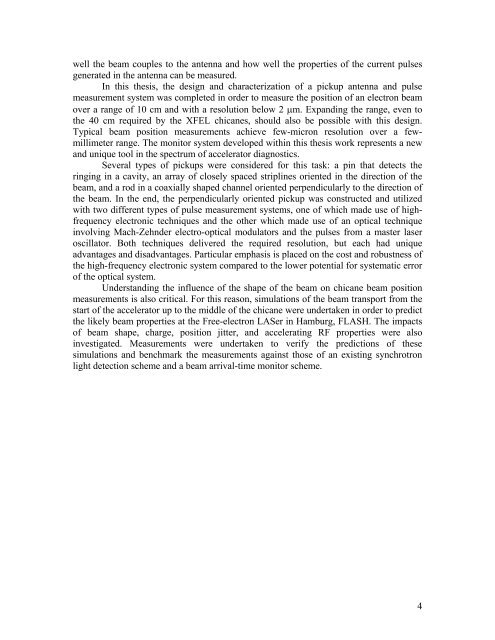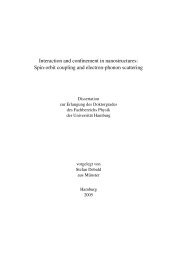Measuring the Electron Beam Energy in a Magnetic Bunch ... - DESY
Measuring the Electron Beam Energy in a Magnetic Bunch ... - DESY
Measuring the Electron Beam Energy in a Magnetic Bunch ... - DESY
You also want an ePaper? Increase the reach of your titles
YUMPU automatically turns print PDFs into web optimized ePapers that Google loves.
well <strong>the</strong> beam couples to <strong>the</strong> antenna and how well <strong>the</strong> properties of <strong>the</strong> current pulses<br />
generated <strong>in</strong> <strong>the</strong> antenna can be measured.<br />
In this <strong>the</strong>sis, <strong>the</strong> design and characterization of a pickup antenna and pulse<br />
measurement system was completed <strong>in</strong> order to measure <strong>the</strong> position of an electron beam<br />
over a range of 10 cm and with a resolution below 2 μm. Expand<strong>in</strong>g <strong>the</strong> range, even to<br />
<strong>the</strong> 40 cm required by <strong>the</strong> XFEL chicanes, should also be possible with this design.<br />
Typical beam position measurements achieve few-micron resolution over a fewmillimeter<br />
range. The monitor system developed with<strong>in</strong> this <strong>the</strong>sis work represents a new<br />
and unique tool <strong>in</strong> <strong>the</strong> spectrum of accelerator diagnostics.<br />
Several types of pickups were considered for this task: a p<strong>in</strong> that detects <strong>the</strong><br />
r<strong>in</strong>g<strong>in</strong>g <strong>in</strong> a cavity, an array of closely spaced stripl<strong>in</strong>es oriented <strong>in</strong> <strong>the</strong> direction of <strong>the</strong><br />
beam, and a rod <strong>in</strong> a coaxially shaped channel oriented perpendicularly to <strong>the</strong> direction of<br />
<strong>the</strong> beam. In <strong>the</strong> end, <strong>the</strong> perpendicularly oriented pickup was constructed and utilized<br />
with two different types of pulse measurement systems, one of which made use of highfrequency<br />
electronic techniques and <strong>the</strong> o<strong>the</strong>r which made use of an optical technique<br />
<strong>in</strong>volv<strong>in</strong>g Mach-Zehnder electro-optical modulators and <strong>the</strong> pulses from a master laser<br />
oscillator. Both techniques delivered <strong>the</strong> required resolution, but each had unique<br />
advantages and disadvantages. Particular emphasis is placed on <strong>the</strong> cost and robustness of<br />
<strong>the</strong> high-frequency electronic system compared to <strong>the</strong> lower potential for systematic error<br />
of <strong>the</strong> optical system.<br />
Understand<strong>in</strong>g <strong>the</strong> <strong>in</strong>fluence of <strong>the</strong> shape of <strong>the</strong> beam on chicane beam position<br />
measurements is also critical. For this reason, simulations of <strong>the</strong> beam transport from <strong>the</strong><br />
start of <strong>the</strong> accelerator up to <strong>the</strong> middle of <strong>the</strong> chicane were undertaken <strong>in</strong> order to predict<br />
<strong>the</strong> likely beam properties at <strong>the</strong> Free-electron LASer <strong>in</strong> Hamburg, FLASH. The impacts<br />
of beam shape, charge, position jitter, and accelerat<strong>in</strong>g RF properties were also<br />
<strong>in</strong>vestigated. Measurements were undertaken to verify <strong>the</strong> predictions of <strong>the</strong>se<br />
simulations and benchmark <strong>the</strong> measurements aga<strong>in</strong>st those of an exist<strong>in</strong>g synchrotron<br />
light detection scheme and a beam arrival-time monitor scheme.<br />
4

















